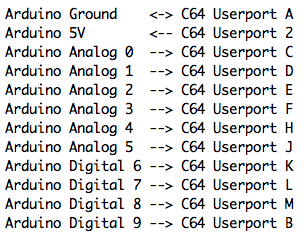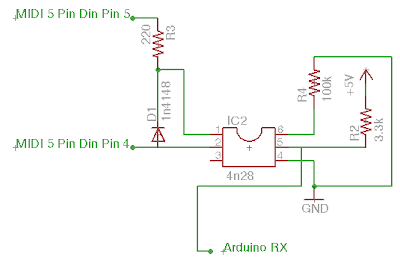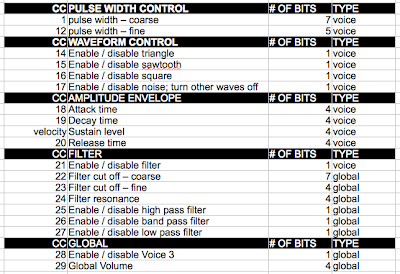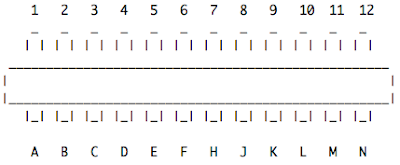Obviously, this post assumes you are familiar with using an Arduino and putting C64 software onto a cartridge. Shoot me an email (seb dot tomczak at gmail dot com) or leave a comment if anything needs clarification for you.
Oh yeah - if you enjoy this sort of stuff, please consider donating a few bucks using the donate button on the right hand side.
Minimum Parts list:
- Arduino board or compatible device (eg. RBBB etc)
- Edge connector
- Wiring
- Breadboard (optional)
- Breadboard jumpers (optional)
- MIDI input circuit (4n28, 1n4148, 220Ω, 3.3kΩ, 100kΩ,) or USB cable
In terms of sourcing the edge connector; you don't need one that is the exact pin count of the C64 Userport - you just need one that is longer. Then simply cut the connector to size. Places that stock arcade parts should have edge connectors. Or just try eBay.
- Breadboard (optional)
- Breadboard jumpers (optional)
- MIDI input circuit (4n28, 1n4148, 220Ω, 3.3kΩ, 100kΩ,) or USB cable
In terms of sourcing the edge connector; you don't need one that is the exact pin count of the C64 Userport - you just need one that is longer. Then simply cut the connector to size. Places that stock arcade parts should have edge connectors. Or just try eBay.
Connections:

 For USB Use:
For USB Use:
Simply attach a USB cable to your Arduino board. You will have to change the baud rate to 57600 in the Arduino code instead of the 31250 MIDI baud rate. You will need to have some form of midi to serial software layer running on your host computer, such as the midi2ser patch (primarily made for OS X).
Software
Download the Arduino code, and upload it to your board or chip.
Download the C64 program and put it onto an EPROM-based cart or other C64 memory device.
Download the midi2ser patch (if using the USB option under OS X)
MIDI Mapping

Demo Video:
Controlling Commodore 64 and SID chip using iPod Touch and DIY MIDI Interface.

 For USB Use:
For USB Use:Simply attach a USB cable to your Arduino board. You will have to change the baud rate to 57600 in the Arduino code instead of the 31250 MIDI baud rate. You will need to have some form of midi to serial software layer running on your host computer, such as the midi2ser patch (primarily made for OS X).
Software
Download the Arduino code, and upload it to your board or chip.
Download the C64 program and put it onto an EPROM-based cart or other C64 memory device.
Download the midi2ser patch (if using the USB option under OS X)
MIDI Mapping

Demo Video:
Controlling Commodore 64 and SID chip using iPod Touch and DIY MIDI Interface.



6 comments:
Now all I need is a Commodore 64!
I'm trying to figure out how to transfer files from my Macbook to the C64, but there doesn't seem to be an easy way. Do you know of any?
I read a lot of helpful info in this post!
Hey Seb.
This looks great. Would it be able to be used to create drum sounds, or is it really for mono/polyphonic melodic parts? - i.e. sending a midi note 60 for a kick sound, midi note note 61 for a snare sound.
Cheers
Joel
Hi, I'm getting ready to build one of these for an upcoming C64 project. Anyone aprt from the author made one?
Quick question, can or does the user port from the C64 supply the power or is the Arduino externally supplied?
I'm using an Uno R3 board, is there anything to be aware of or will the circuit work as described?
Thanks
Would this work with M64 or other midi-to-SID software.
I want to use my C64 and some midi drum triggers to bang out some nasty SID sounds live.
Post a Comment